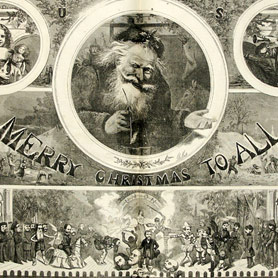The little known connection of Middle Village with the Modern Day Image of Santa Claus
James Harper was born in England. At 26 years of age he lived in Newtown in an area now called Middle Village. He had four sons named James, John, Joseph and Fletcher.The Harper home had thirty-eight acres of farmland and was located across the street from the Middle Village El Station.
In 1810 Harper’s son James left his home in Middle Village to learn the printing trade. In 1817, two young brothers, James (22) and John (20), established a small printing firm in New York. Two other brothers, Joseph Harper and Fletcher Harper, joined the company and by 1825 Harper & Brothers was the largest book publisher in the United States.
In later years the printing company's fame had spread around the world. James, with the help of his brothers, not only published books but they were also the publishers of Harper's Bazaar and Harper's Weekly.
The Harper Brothers hired Thomas Nast, 1840-1908. Nast became one of America's most influential political cartoonists. He created the figures: Uncle Sam, the Republican elephant, the Democratic donkey and Columbia. These figures have become American icons.
Nast was only 15 years of age when he joined the Harper Company. While still in his teens he began attacking political corruption through his woodblock engravings. He became a crusading journalist, using pictures instead of words. His art commanded an emotional response. The patriotic cartoons Nast drew for Harper's Weekly during the Civil War led President Lincoln to call him the Union's best recruiting sergeant. Also, Nast is given much of the credit for the downfall of the ring headed by “Boss” William Marcy Tweed that defrauded the New York City Treasury of at least $30,000,000. Newspaper articles exposed the facts and figures of the Tweed ring's graft but it was Nast's drawings that galvanized public indignation.
There was, however, a softer side to Nast's work ( a side apart from national affairs and sordid politics) that was drawn out by the spirit of Christmas. It was Nast who gave us our image of Santa Claus. The fat, jolly old gentleman with white beard and fur-trimmed suit – based on Clement Moore's poem (inspired by thoughts of his grandparents' home on Broadway in Elmhurst), “Visit from St. Nicholas” better known as “The Night Before Christmas.” It was Nast's imagination that put Santa's workshop at the North Pole.
He delighted in drawing Christmas as children see it – the reindeer and sleigh landing on a snowy roof, Santa's entrance through the chimney with a bulging bag of presents, stockings hung from the mantle in happy anticipation, toys and sweets and warm homemade wreath made festive with holly and mistletoe. Every Christmas for over thirty years, Nast's delightful illustrations appeared in Harper's.
Thomas Nast, Who Stole the People's Money? Cartoon showing William Tweed, Peter Sweeney, Richard Connolly and Oakley Hall that appeared in Harper's Weekly (19th August, 1871)



